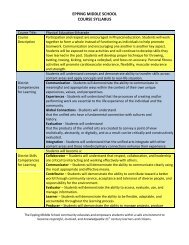Reading Standards for Informational Text & Literature - SAU 14
Reading Standards for Informational Text & Literature - SAU 14
Reading Standards for Informational Text & Literature - SAU 14
You also want an ePaper? Increase the reach of your titles
YUMPU automatically turns print PDFs into web optimized ePapers that Google loves.
Grade Four<br />
<strong>Standards</strong><br />
Key Ideas and Details<br />
1. Refer to details and examples in a text when<br />
explaining what the text says explicitly and<br />
when drawing inferences from the text.<br />
2. Determine a theme of a story, drama, or poem<br />
from details in the text; summarize the text.<br />
3. Describe in depth a character, setting, or event<br />
in a story or drama drawing on specific details in<br />
the text (e.g., a character’s thoughts, words, or<br />
actions).<br />
Craft and Structure<br />
4. Determine the meaning of words and phrases<br />
as they are used in a text including those that<br />
allude to significant characters found in<br />
mythology (e.g. Herculean).<br />
5. Explain major differences between poems,<br />
drama, and prose, and refer to the structural<br />
elements of poems (e.g., verse, rhythm, meter)<br />
and drama (e.g., casts of characters, settings,<br />
descriptions, dialogue, stage directions) when<br />
writing or speaking about a text.<br />
6. Compare and contrast the point of view from<br />
which different stories are narrated including<br />
the difference between first- and third-person<br />
narrations.<br />
Integration of Knowledge and Ideas<br />
7. Make connections between the text of a story<br />
or drama and a visual or oral presentation of<br />
the text identifying where each version reflects<br />
specific descriptions and directions in the text.<br />
8. (not applicable to literature) N/A<br />
9. Compare and contrast the treatment of similar<br />
themes and topics (e.g., the quest) in stories,<br />
myths, and traditional literature from different<br />
cultures.<br />
Range of <strong>Reading</strong> and Level of <strong>Text</strong> Complexity<br />
10. By the end of the year, read and comprehend<br />
literature, including stories, dramas, and poetry,<br />
at the high end of the grades 4-5 text<br />
complexity band independentlyand proficiently.<br />
I can… Statements<br />
I can state details and examples from text when<br />
explaining what the text says.<br />
I can state in<strong>for</strong>mation from text from inferences.<br />
I can tell what the theme of a story, drama, or<br />
poem is from details in the text.<br />
I can summarize the text.<br />
I can talk about story elements by giving specific<br />
details in a text.<br />
I can tell what the words and phrases used in a<br />
text mean including those that refer to important<br />
characters found in mythology.<br />
I can explain the major differences between<br />
poems, drama, and prose when writing or<br />
speaking about a text.<br />
I can compare and contrast the point of view from<br />
stories .<br />
I can discuss different presentations of text.<br />
I can compare and contrast the treatment of<br />
topics in literature from different cultures.<br />
I can read and understand complex literature<br />
independently and accurately.<br />
<strong>Reading</strong> <strong>Standards</strong> – In<strong>for</strong>mational <strong>Text</strong> and <strong>Literature</strong> Epping School District Page 12 of 16
















